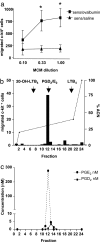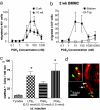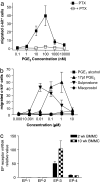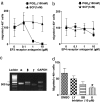Chemotactic action of prostaglandin E2 on mouse mast cells acting via the PGE2 receptor 3
- PMID: 17606905
- PMCID: PMC1913869
- DOI: 10.1073/pnas.0701700104
Chemotactic action of prostaglandin E2 on mouse mast cells acting via the PGE2 receptor 3
Abstract
Mast cells are long-lived cells that are principally recognized for their effector function in helminth infections and allergic reactions. These cells are derived from pluripotential hematopoietic stem cells in the bone marrow that give rise to committed mast cell progenitors in the blood and are recruited to tissues, where they mature. Little is known about the chemotactic signals responsible for recruitment of progenitors and localization of mature mast cells. A mouse model was set up to identify possible mast cell progenitor chemoattractants produced during repeated allergen challenge in vivo. After the final challenge, the nasal mucosa was removed to produce conditioned medium, which was tested in chemotaxis assays against 2-wk murine bone marrow-derived c-kit+ mast cells (BMMC). A single peak of chemotactic activity was seen on reverse-phase HPLC with a retention time and electrospray mass spectrum consistent with prostaglandin E2 (PGE2). This lipid was found to be a highly potent chemoattractant for immature (2-wk) and also mature (10-wk) BMMC in vitro. Fluorescently labeled 2-wk c-kit+ BMMC, when injected intravenously, accumulated in response to intradermally injected PGE2. Analysis using TaqMan showed mRNA expression of the PGE2 receptors 3 (EP3) and 4 (EP4) on 2- and 10-wk BMMC. Chemotaxis induced by PGE2 was mimicked by EP3 agonists, blocked by an EP3 receptor antagonist, and partially inhibited by a MAPKK inhibitor. These results show an unexpected function for PGE2 in the chemotaxis of mast cells.
Figures




Similar articles
-
Leukotriene B4, an activation product of mast cells, is a chemoattractant for their progenitors.J Exp Med. 2005 Jun 20;201(12):1961-71. doi: 10.1084/jem.20042407. Epub 2005 Jun 13. J Exp Med. 2005. PMID: 15955837 Free PMC article.
-
Prostaglandin E2 selectively enhances the IgE-mediated production of IL-6 and granulocyte-macrophage colony-stimulating factor by mast cells through an EP1/EP3-dependent mechanism.J Immunol. 2000 Dec 1;165(11):6545-52. doi: 10.4049/jimmunol.165.11.6545. J Immunol. 2000. PMID: 11086097
-
Prostaglandin E2-EP3 signaling induces inflammatory swelling by mast cell activation.J Immunol. 2014 Feb 1;192(3):1130-7. doi: 10.4049/jimmunol.1300290. Epub 2013 Dec 16. J Immunol. 2014. PMID: 24342806
-
[Cooperation of two subtypes of PGE2 receptor, Gi coupled EP3 and Gs coupled EP2 or EP4 subtype].Yakugaku Zasshi. 2003 Oct;123(10):837-43. doi: 10.1248/yakushi.123.837. Yakugaku Zasshi. 2003. PMID: 14577329 Review. Japanese.
-
Prostaglandin E2-induced inflammation: Relevance of prostaglandin E receptors.Biochim Biophys Acta. 2015 Apr;1851(4):414-21. doi: 10.1016/j.bbalip.2014.07.008. Epub 2014 Jul 17. Biochim Biophys Acta. 2015. PMID: 25038274 Review.
Cited by
-
The function of CCR3 on mouse bone marrow-derived mast cells in vitro.Immunology. 2010 Jan;129(1):115-24. doi: 10.1111/j.1365-2567.2009.03151.x. Immunology. 2010. PMID: 20050333 Free PMC article.
-
Future Needs in Mast Cell Biology.Int J Mol Sci. 2019 Sep 6;20(18):4397. doi: 10.3390/ijms20184397. Int J Mol Sci. 2019. PMID: 31500217 Free PMC article. Review.
-
Prostaglandins in asthma and allergic diseases.Pharmacol Ther. 2019 Jan;193:1-19. doi: 10.1016/j.pharmthera.2018.08.001. Epub 2018 Aug 3. Pharmacol Ther. 2019. PMID: 30081047 Free PMC article. Review.
-
Arachidonic Acid Derived Lipid Mediators Influence Kaposi's Sarcoma-Associated Herpesvirus Infection and Pathogenesis.Front Microbiol. 2019 Mar 12;10:358. doi: 10.3389/fmicb.2019.00358. eCollection 2019. Front Microbiol. 2019. PMID: 30915039 Free PMC article. Review.
-
Krill Oil Treatment Increases Distinct PUFAs and Oxylipins in Adipose Tissue and Liver and Attenuates Obesity-Associated Inflammation via Direct and Indirect Mechanisms.Nutrients. 2021 Aug 18;13(8):2836. doi: 10.3390/nu13082836. Nutrients. 2021. PMID: 34444996 Free PMC article.
References
-
- Marshall JS. Nat Rev Immunol. 2004;4:787–799. - PubMed
-
- Pipkorn U, Karlsson G, Enerback L. Journal of Allergy and Clinical Immunology. 1988;82:1046–1054. - PubMed
-
- Fokkens WJ, Godthelp T, Holm AF, Blom H, Mulder PG, Vroom TM, Rijntjes E. Clin Exp Allergy. 1992;22:701–710. - PubMed
-
- Nouri-Aria KT, Pilette C, Jacobson MR, Watanabe H, Durham SR. Journal of Allergy and Clinical Immunology. 2005;116:73–79. - PubMed
Publication types
MeSH terms
Substances
Grants and funding
LinkOut - more resources
Full Text Sources

